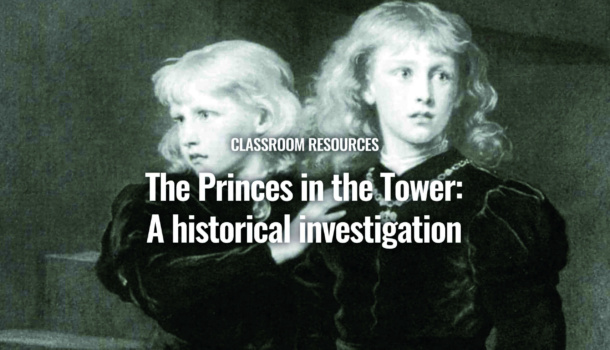The Princes in the Tower – A historical investigation
A series of lesson plans and resources based around the Wars of the Roses and one of the most captivating mysteries in British history – the murder of the Princes in the Tower.
£25+ VAT
Purchase this teaching resource
- up to 300 users
- up to 300 users
- up to 300 users
Over 500 years ago, two young princes disappeared from the Tower of London, never to be seen again – what happened? Reopen the case with a series of investigative activities for Key Stage 3 and beyond, and discover a tangled web of greed, murder and intrigue amid a brutal battle for the throne of England.
When Edward IV became king for the second time on 11 April 1471, it appeared that he brought to an end one of the most tumultuous and brutal times of the Middle ages, the Wars of the Roses. It must have been felt by many that the Plantagenet dynasty would continue for many years under the House of York.
It was not to be. In 1483, after Edward IV’s sudden death in Westminster, his and Elizabeth Woodville’s two young sons were imprisoned in the Tower of London. The princes were never seen again, and their disappearance led, albeit indirectly, to the death of Richard III, the last male heir to the House of York. The exact circumstances of the princes’ disappearance has intrigued historians for hundreds of years, but what do we know about what really happened to the Princes in the Tower? And what were the events that led to King Richard III being accused of the murder of his nephews?
The disappearance of the young king and his brother is one of the greatest mysteries of English history. Did Richard III, the last of the Plantagenets, really murder the sons of Edward IV, as his Tudor successors – including their illustrious propagandist, William Shakespeare – always alleged? Or was there someone else who would benefit from the princes’ deaths? The backdrop to this mystery is the Wars of the Roses, a period in history which lends itself to investigation of events, battles and motives.

This cross curricular project includes:
‘The Mystery of the Princes in the Tower’ text
A detailed outline of the events leading up to the crowning of King Richard III and the disappearance of his young nephews, the Princes in the Tower. Available as a word document (formatted to make mass printing easier and more cost effective).
Image bank
A collection of images linked to the Wars of the Roses and the Princes in the Tower.
Activity 1: Activating prior knowledge
This activity encourages pupils to read with purpose and engagement while calling up prior knowledge to connect new learning with current understanding. Includes instructions and:
- Activity sheet 1 – Reading and discussing texts together
Activity 2: Reading the text
Students take on a reading role and read the text, ‘The Mystery of the Princes in the Tower’, from that perspective, contributing to a group record sheet. This activity encourages active thinking and reading and encourages students to work collaboratively, but independently. Includes instructions and:
- Activity sheet 2a – Reading roles record sheet
- Activity sheet 2b – RECALL Strategy sheet (an alternative collection sheet to Activity sheet 2a)
- Activity sheet 2c – Group roles cards (to cut out and assign to each student)
- Activity sheet 2d – WOW worksheet (Working Out Words)
Activity 3: Summarising information
Students retell a story in a specified number of words to improve summarising skills. Includes instructions and:
- Activity sheet 3 – ‘In a nutshell…’
Activity 4: Timeline of disappearance
Students act as research detectives to create a timeline representing the events leading up to the disappearance of the princes in the tower. Includes instructions and:
- Activity sheet 4a – Research task introduction
- Activity sheet 4b – Brainstorm template
Activity 5: Who murdered the princes in the tower?
Students examine a collection of sources and make a judgement as to who murdered the princes in the tower. Includes instructions and:
- Activity sheet 5a – Research task introduction
- Activity sheet 5b – Sources (This sheet includes 20)
- Activity sheet 5c – Lotus diagram template
Activity 6: Edward III’s family tree
In this activity, students research and draw King Edward III’s family tree, and examine the connections between the Houses of York and Lancaster. Includes instructions and:
- Activity sheet 6a – Brainstorm template
- Activity sheet 6b – Edward III’s family tree (example copy)
Activity 7: The causes of the Wars of the Roses
Whole-class activity identifying the events leading to the first Battle of St Albans. This activity involves assigning students to play key historical figures and moving them around the classroom according to alliances and events. The procedure is detailed in Activity sheet 7a. Students then write a report or explanation of the causes of the Wars of the Roses. Includes instructions and:
- Activity sheet 7a – Teacher’s crib sheet
- Activity sheet 7b – Student introduction
- Activity sheet 7c – Key figures student help sheet
- Activity sheet 7d – Classroom situation cards
- Activity sheet 7e – Key figures role cards
Activity 8: Wars of the Roses timeline
Students research and represent the major battles and events of the Wars of the Roses in a timeline. Includes instructions and:
- Activity sheet 8a – Research task introduction
- Activity sheet 8b – Battles research grid
- Activity sheet 8c – Completed battles research grid (Teacher’s crib sheet)
- Activity sheet 8d – Key events of the Wars of the Roses
Activity 9: Decision line/Hot seating
Students use a decision line to visually represent information and judgements or alternatively, hot seat a key figure from the time period to gain a deeper understanding of motives and actions. Includes activity instructions.

